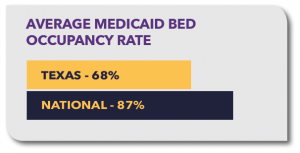The 85th Legislature should reduce Excess Medicaid Beds
Industry experts suggest one way Texas can help improve the quality of nursing home care in the state would be to strengthen the state’s Medicaid Bed Allocation Program. Doing so will help eliminate excess bed capacity, which contributes to lower quality of care and creates price inflation.
BACKGROUND
One of the quickest — and cost free — ways to improve the quality of care in Texas nursing homes is to limit the number of Medicaid beds, eliminating existing excess capacity. As many as 30-percent of Medicaid beds in Texas long-term care facilities are empty, well over the national average of 12-percent. And when a long-term care facility cannot fill its beds, fixed costs must be managed by cutting costs and charging more.
EXCESS MEDICAID BEDS: REDUCED QUALITY AND HIGHER COSTS
 When underutilized facilities are not able to improve their infrastructure and programs, resident care suffers. When they are unable to invest in their staff, increased stress on understaffed caregivers contributes to high turnover. High turnover results in inconsistent care, additional costs to train and replace workers who leave, and ultimately increased rehospitalizations. Residents who live in understaffed nursing homes are at greater risk of malnutrition, weight loss, bedsores, dehydration, infections and pneumonia. Too many nursing facilities in the same community creates a strain on an industry already struggling to attract and retain skilled caregivers.
When underutilized facilities are not able to improve their infrastructure and programs, resident care suffers. When they are unable to invest in their staff, increased stress on understaffed caregivers contributes to high turnover. High turnover results in inconsistent care, additional costs to train and replace workers who leave, and ultimately increased rehospitalizations. Residents who live in understaffed nursing homes are at greater risk of malnutrition, weight loss, bedsores, dehydration, infections and pneumonia. Too many nursing facilities in the same community creates a strain on an industry already struggling to attract and retain skilled caregivers.
The annual staff turnover rate in Texas is one of the highest in the nation. In 2014, the turnover rate in Texas nursing homes was 94 percent for registered nurses, 86 percent for licensed vocational nurses and 104 percent for certified nursing assistants (CNAs), meaning some homes experienced a complete turnover of CNAs within a single year.
 Overcapacity creates price inflation as operators are forced to spread their costs for operations over a smaller number of residents. These higher costs are passed on to private payers and public programs like Medicaid. In 2015 the state of Indiana passed a three-year nursing home bed moratorium to address its overcapacity and save state funds. The legislation was projected to save the state’s Medicaid program $24 million by reducing cost of care created by inflation-related overcapacity.
Overcapacity creates price inflation as operators are forced to spread their costs for operations over a smaller number of residents. These higher costs are passed on to private payers and public programs like Medicaid. In 2015 the state of Indiana passed a three-year nursing home bed moratorium to address its overcapacity and save state funds. The legislation was projected to save the state’s Medicaid program $24 million by reducing cost of care created by inflation-related overcapacity.
MAJORITY OF STATES CONTROL NURSING HOME BED GROWTH
According to the National Conference of State Legislatures, 35 states currently maintain a process to manage health facility growth. Most are concentrated on outpatient and long term care facilities. For the long term care industry, these laws generally require that anyone attempting to add beds must establish the need for a nursing home in a given area before adding more Medicaid beds. Texas is among those states, but over the years exemptions to the state’s Medicaid Bed Allocation Program have diluted its effectiveness, contributing to a glut of empty nursing home beds.

IMPROVING CARE AND REDUCING COSTS
Texas’s oversupply of Medicaid beds creates health care price inflation and contributes to staff turnover, health care worker shortages and poor patient care. Wisely planning how these beds are distributed reduces overall facility costs, lowers the cost of care for private and public payers, and diminishes turnover of limited available nursing staff. In short, higher occupancy rates lower per‑resident costs and results in better care.
Texas should stop adding Medicaid beds until a process can be developed that allows occupancy rates to serve as the basis for adding additional capacity.

